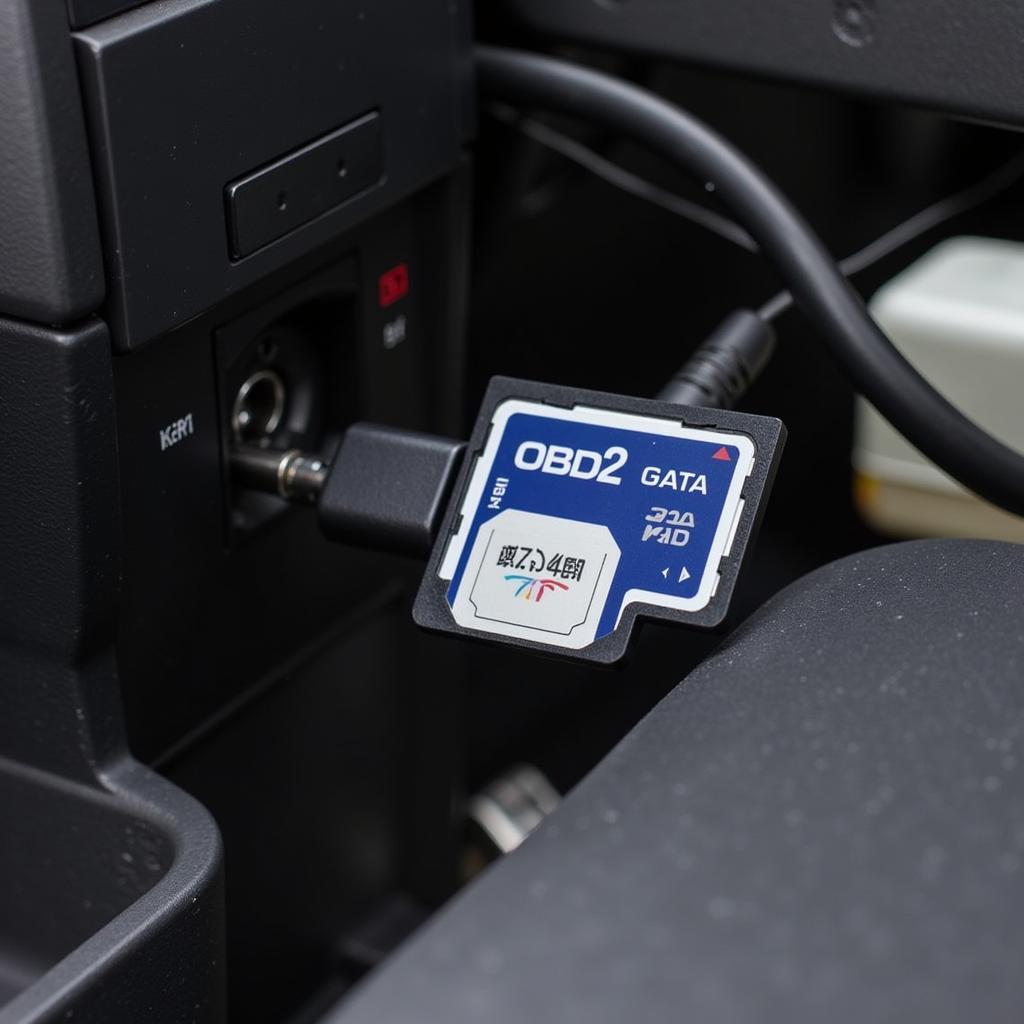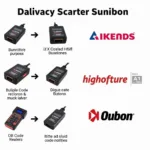An OBD2 data logger SD card is a simple yet powerful tool that can significantly enhance your understanding of your vehicle’s performance. By recording various parameters from your car’s computer, these devices offer a wealth of information that can be used for everything from troubleshooting engine issues to improving fuel efficiency.
What is an OBD2 Data Logger SD Card?
An OBD2 data logger SD card is a type of on-board diagnostics (OBD) device that plugs into your vehicle’s OBD-II port, typically located under the dashboard on the driver’s side. Unlike basic code readers, data loggers continuously record a wide range of data points while you drive, storing them on an SD card for later analysis.
Why Use an OBD2 Data Logger SD Card?
The information gathered by an OBD2 data logger can be invaluable for:
- Diagnosing Car Problems: Pinpoint the root cause of engine trouble codes, intermittent issues, or performance problems.
- Monitoring Vehicle Health: Track vital parameters like engine temperature, coolant levels, and battery voltage to stay ahead of potential issues.
- Improving Fuel Efficiency: Analyze driving habits and identify areas where adjustments can be made to conserve fuel.
- Enhancing Performance: Monitor parameters like speed, acceleration, and RPM to optimize driving techniques for better performance on the track or road.
- Tracking Vehicle Usage: Log mileage, trip duration, and other data points for business purposes, fleet management, or personal record-keeping.
How Does an OBD2 Data Logger SD Card Work?
The process is straightforward:
- Plug and Drive: Simply insert the data logger into your vehicle’s OBD-II port and start driving. The device will automatically begin recording data.
- Retrieve and Analyze: Once you’ve finished driving, remove the SD card and insert it into your computer or a compatible card reader.
- Utilize Software: Use the provided software or a compatible third-party application to access, analyze, and interpret the recorded data.
What Data Can Be Logged?
Depending on the model and software capabilities, an OBD2 data logger SD card can record a wide range of information, including:
- Engine Speed (RPM)
- Vehicle Speed
- Throttle Position
- Engine Load
- Coolant Temperature
- Intake Air Temperature
- Fuel Pressure
- Oxygen Sensor Readings
- Mass Air Flow
- Ignition Timing
- Battery Voltage
- GPS Location
- And much more…
Choosing the Right OBD2 Data Logger SD Card
Consider these factors when selecting a data logger:
- Vehicle Compatibility: Ensure the device is compatible with your vehicle’s make, model, and year.
- Data Logging Capabilities: Determine the specific parameters you want to track and choose a model that offers those features.
- Storage Capacity: Opt for a device with ample storage space on the SD card, especially if you plan on recording long trips or multiple driving sessions.
- Software Features: Look for intuitive and user-friendly software that provides clear data visualization, analysis tools, and reporting options.
- Ease of Use: Choose a device that’s simple to install, operate, and retrieve data from.
Benefits of Using an OBD2 Data Logger SD Card
- Early Problem Detection: Identifying minor issues before they escalate into major repairs can save you time and money.
- Improved Fuel Economy: Understanding your driving habits and making adjustments based on data insights can lead to significant fuel savings.
- Enhanced Driving Skills: Analyzing driving data can help identify areas for improvement, whether it’s smoother acceleration or more efficient braking.
- Peace of Mind: Having a record of your vehicle’s performance provides valuable documentation in case of insurance claims or disputes.
OBD2 Data Logger SD Card: A Valuable Tool for All Drivers
From casual car owners to professional mechanics, an OBD2 data logger SD card is a valuable tool that provides a deeper understanding of vehicle performance. Its ability to record, store, and analyze critical data offers numerous benefits, making it a worthwhile investment for anyone looking to enhance their driving experience and optimize their vehicle’s health.
Frequently Asked Questions
1. Can I use any SD card with an OBD2 data logger?
While most OBD2 data loggers utilize standard SD cards, it’s crucial to check the manufacturer’s specifications for compatibility and recommended card types.
2. Is it difficult to install and use an OBD2 data logger?
No, OBD2 data loggers are designed for plug-and-play operation. Simply insert the device into your vehicle’s OBD-II port and you’re ready to go.
3. Can I use an OBD2 data logger with my smartphone?
Some OBD2 data loggers offer Bluetooth connectivity, allowing you to wirelessly transmit data to your smartphone or tablet for analysis.
4. What software do I need to analyze the recorded data?
Most OBD2 data loggers come bundled with proprietary software. Additionally, numerous third-party applications are available, offering a range of features and analysis capabilities.
5. Are OBD2 data loggers legal to use?
Yes, OBD2 data loggers are legal to use for personal monitoring and diagnostics. However, it’s essential to check local regulations regarding data logging for commercial vehicles or specific applications.
Still have questions?
Need more information about OBD2 data loggers or other OBD2 solutions? Visit our other helpful articles:
Contact us for personalized assistance through WhatsApp: +1(641)206-8880 or Email: [email protected]. Our dedicated customer support team is available 24/7 to help you find the right OBD2 solution for your needs.

